547-211日本三丰数显深度尺说明书
- 格式:doc
- 大小:66.50 KB
- 文档页数:5
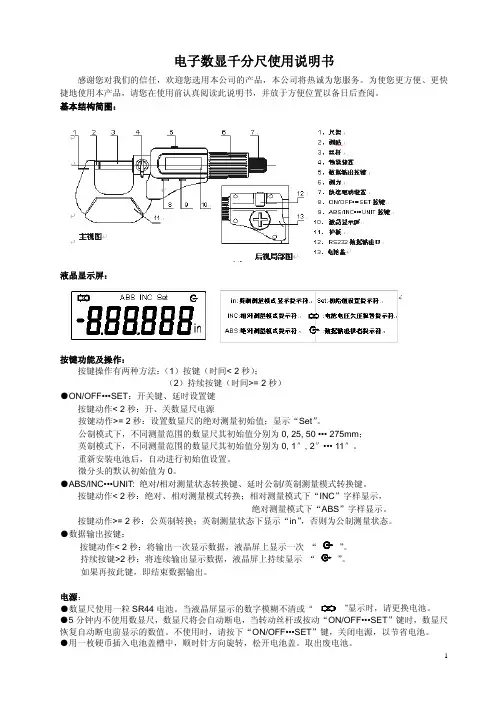
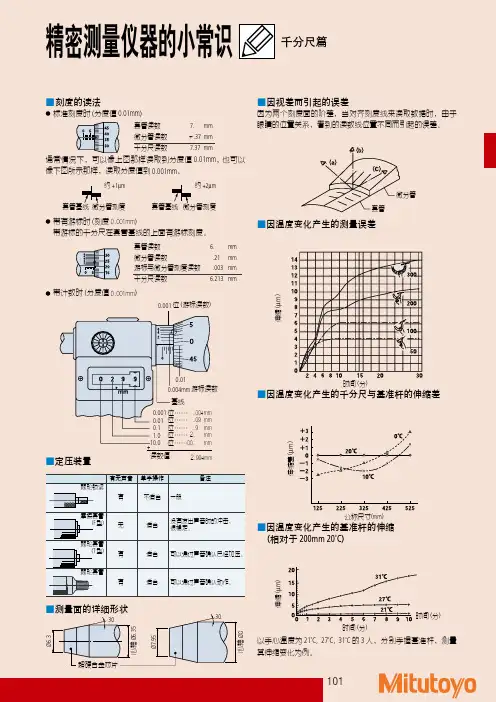
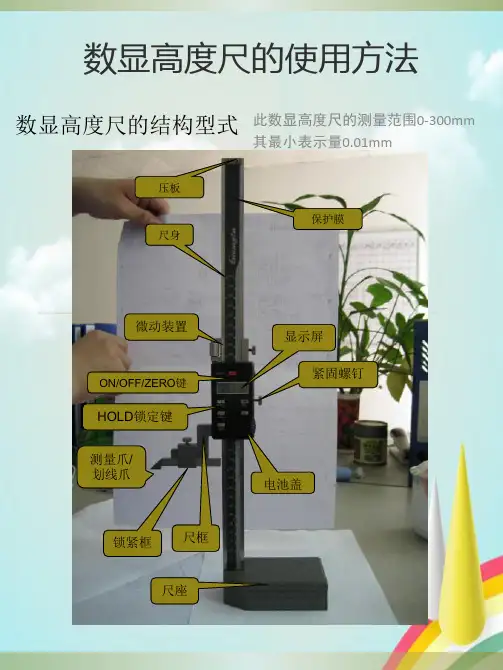
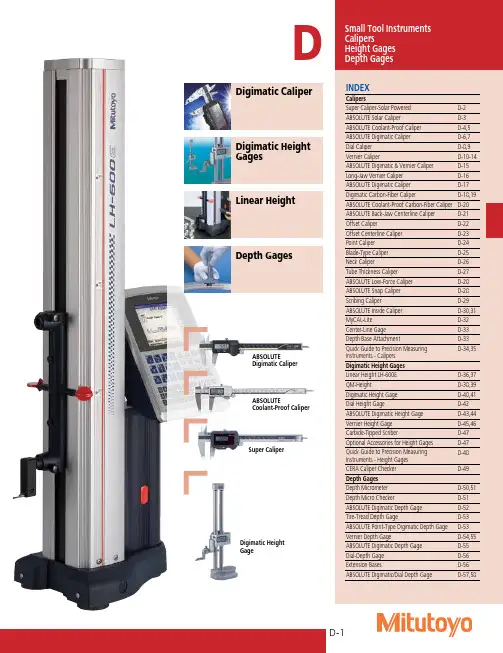
ABSOLUTEDigimatic CaliperABSOLUTECoolant-Proof CaliperSuper CaliperDigimatic HeightGage500-784Direction of the lengthDirection of the lengthRa: 0.126µmRa: 0.07µm• With thumb roller.• Supplied in fitted plastic case. 500-474Technical DataAccuracy: Refer to the list of specifications Resolution: .0005"/0.01mm or 0.01mm Repeatability: .0005” / 0.01mm Display: LCD• Supplied in fitted plastic case.500-763-20500-752-20Measurement data output function is available 05CZA624Technical DataAccuracy: Refer to the list of specifications Resolution: .0005”/0.01mm or 0.01mm Repeatability: .0005”/ Display: LCD Direction of the lengthDirection of the lengthwooden case.959143959149500-197-30500-151-30The new Mitutoyo ABS Digimatic Caliper line with500-502-10500-501-10500-500-10505-732505-745505-742-56.100” per revolution.200” per revolution1mm per revolution2mm per revolution505-7461. Outside measurement2. Inside measurement3. Step measurement4. Depth measurement530-101530-109Carbide-tippedCarbide-tipped jaw typeRound depth bar typeOD measurementID measurementStep measurementDepth measurement531-101Thumb clampStep measurementDepth measurementOD measurementID measurement532-101 OD measurementID measurementStep measurementDepth measurement160-101160-116160-131 550-311-10534-114552-314-10552-155-10FunctionOrigin-set, Zero-setting, Presetting, Offsetting, Data hold,Centerline Attachments Pointed ID MeasuringAttachment Clamps552-151-10 Ceramic jaws552-192-10 with optional interchangeable jaws573-117-10(Center-to-center type)573-119-10(Edge-to-center type) SPECIFICATIONS536-101 573-701-20573-705-20536-105 SPECIFICATIONSto obtain.573-721-20536-121573-734-20 536-134573-751-20536-151536-152Point jaw typeSPECIFICATIONSMetric Range Order No.Accuracy Resolution Mass(g)573-761-20536-161Digital model• Supplied in fitted plastic case.to allow quick and efficient go/no-goSPECIFICATIONSMetric Range Order No.Accuracy Resolution SPECIFICATIONSMetric Measurement procedures• Supplied in fitted plastic case.573-191-30573-282-30Technical DataAccuracy: Refer to the list of specifications Resolution*: .0005”/0.01mm / 0.01mm Graduation**: 0.05mm Display*: LCDLength standard*: ABSOLUTE electrostatic capacitance type linear encoderMax. response speed*: Unlimited 573-742-20536-142536-145536-146573-746-20573-745-20wooden case.Point-jaw type700-113-10 700-123-10050001Application for 4”, 6” and 8” Vernier,Dial and Digimatic Calipers, requiringdimensions over .375”.Depth baseattachmentD-34■ NomenclatureSliderBeam Reference surfaceMain scale Depth barDepth measuring facesThumb-rollerZERO Set/ABSOLUTE buttonOutput connectorLocking screwOutside measuring facesOutside jawsInside jaws Inside measuring faces Step measuring faces本尺目盛目盛板本尺目盛バーニヤ目盛■ How to Read the Scale●Dial Calipers●Vernier CalipersGraduation 0.01mmMain scale16 mm Vernier 0.15 mm Reading16.15 mmGraduation 0.05mm(1)(2)Main scale 16 mm Dial face 0.13 mm Reading16.13 mm(1)(2)Graduation 0.05mm(1)(2)Main scale reading 16 mmDial face reading 0.13 mmDial Caliper reading 16.13 mm (1)(2)0Main scale Dial faceMain scale Vernier scale501080307090406020010203040(1)(1)(1)(2)(2)(2)(2)Main scaleDial face501080307090406020②①001234567891010203040■ Special Purpose Caliper ApplicationsPoint jaw typeOffset jaw typeDepth typeBlade jaw typeFor uneven surface measurementFor stepped feature measurement For depth measurementFor diameter of narrow groove measurementVernier CaliperAbsolute Digimatic Caliper ■ Measurement applications1. Outside measurement2. Inside measurement4. Depth measurement3. Step measurementNote) Above left, 0.15 mm (2) is read at the position where a main scale graduation line corresponds with a verniergraduation line.CalipersQuick Guide to Precision Measuring InstrumentsStep measuring facesGib, sliderLocking screwScrew, gib pressingBeamStopper, sliderDepth measuring facesMain scale Reference surfaceThumbwheelVernier scale SliderInside measuring faces Inside jaws Outside jawsOutside measuring facesScrew, gib setting Depth barD-35■ About Long CalipersSteel rules are commonly used to roughly measure large workpieces, but if more accuracy is needed, then a long caliper is suitable for the job. A long caliper is convenient for its user friendliness but does require some care during use. In the first place it is important to realize there is no relationship between resolution and accuracy. For details, refer to the values in our catalog. Resolution is constant whereas the accuracy obtainable varies dramatically according to how the caliper is used.The measuring method with this instrument is a concern since distortion of the main beam causes a large amount of the measurement error, so accuracy will vary greatly depending on the method used for supporting the caliper at the time. Also, be careful not to use too much measuring force when using the outside measuring faces as they are furthest away from the main beam so potential errors will be at a maximum here. This precaution is also necessary when using the tips of the outside measuring faces of a long-jaw caliper.■ Vernier scaleThis is a short auxiliary scale that enables accurate interpolation between the divisions of a longer scale without using mechanical magnification. The principle of operation is that each vernier scale division is slightly smallerthan a main scale division, so that successive vernier graduations successivelycoincide with main scale graduations as one is moved relative to the other. Specifically, n divisions on a vernier scale are the same length as n-1 divisions on the main scale it works with, and n defines the division (or interpolation) ratio. Although n may be any number, in practice it is typically 10, 20, 25, etc., so that the division is a useful decimal fraction. The example below is for n = 10. The main scale is graduated in mm, and so the vernier scale is 9mm (10 divisions) long, the same as 9mm (9 divisions) on the main scale. This produces a difference in length of 0.1mm (1) as shown in figure A (the 1st vernier graduation is aligned with the first main scale graduation). If the vernier scale is slid 0.1mm to the right as shown in figure B, the 2nd graduation line on the vernier scale moves into alignment with the 2nd line on the main scale (2), and so enables easy reading of the 0.1mm displacement.Some early calipers divided 19 divisions on the main scale by 20 vernier divisions to provide 0.05mm resolution. However, the closely spaced lines proved difficult to read and so, since the 1970s, a long vernier scale that uses 39 main scale divisions to spread the lines is generally used instead, as shown below.1234567891024681010203040304050607039mm19mm 0.05mmScale reading 1.45mm Scale reading 30.35mm Calipers were made that gave an even finer resolution of 0.02mm. These required a 49-division vernier scale dividing 50 main scale divisions. However,they were difficult to read and are now hard to find since digital calipers with an easily read display and resolution of 0.01mm appeared.■ Inside Measurement with a CM-type CaliperBecause the inside measuring faces of a CM-type caliper are at the tips of the jaws, the measuring face parallelism is heavily affected by measuring force, and this becomes a large factor in the measurement accuracy attainable. In contrast to an M-type caliper, a CM-type caliper cannot measure a very small hole diameter because it is limited to the size of the stepped jaws,although normally this is not an inconvenience as it would be unusual to have to measure a very small hole with this type of caliper. Of course, the radius of curvature on the inside measuring faces is always small enough to allow correct hole diameter measurements right down to the lowest limit (jaw closure).Mitutoyo CM-type calipers are provided with an extra scale on the slider for inside measurements so they can be read directly without the need for calculation, just as for an outside measurement. This useful feature eliminates the possibility of error that occurs when having to add the inside-jaw-thickness correction on a single-scale caliper.■ Small hole measurement with an M-type caliperStructural error (d) occurs when you measure the internal diameter of a small hole.øD : True internal diameter ød : Measured diametert 1, t 2: Thickness of the inside jaw C: Distance between the inside jaws d: Measurement error (øD – ød)True internal diameter (øD: 5mm) Unit: mm t 1+t 2+C 0.30.50.7d 0.0090.0260.047For inside onlyFor outside only● 19mm Vernier scale● 39mm vernier scale (long vernier scale)ød t 2t 1C øDød øDveC-type Standard outside measurementInside measurement of a stepped hole Measurement of a stepped part CN-typeStandard outside measurement Measurement of a stepped hole Measurement of a stepped part1234567891024681010203040304050607039190.05mm9mm (9 graduation lines)(1) 0.1mm 0.1mmDivided into10 equal divisionsAB(2) Aligned518-351A-215.7” color LCD55inch type: ø3/8”mm type: ø8øA 957262(45)54ø85.3)ø4ø6ø19ø14ø1485ø8øø2 ruby ball probeTechnical DataMeasuring range*:Slider stroke:Resolution:Accuracy at 20°C:Guiding method:Drive method:Length standard:Measuring force:Display: LCDPower supply:Battery operation time: Refer to the list of specifications* Maximum values are obtained with the probe at thehighest position. Any change of the probe orientationrequires the coordinate system be re-zeroed. With the probein the highest position, minimum measurable height is4.53”/115mm.64PKA129AShown with optional touch-signal probeSPECIFICATIONSInch/MetricRange0-12”/0-300mm0-18”/0-450mm0-24”/0-600mm0-40”/0-1000mmMetricRange0-300mm0-600mm0-1000mm192-630-10192-150Comfortable grip baseEasy and secure clampingEasy and error-free readingSPECIFICATIONSMetricRange0 - 200mm0 - 1000mmInch/MetricRange0 - 8" /0 - 200mm0 - 40" /0 - 1000mm570-244570-312570-304Large, smooth slider-feed wheelLarge clamp leverComfortable grip base• Zero reference point can be adjusted.• Satin chrome-finished scales for glare-free• Optional magnifier for easier reading514-102514-103506-207506-208 SPECIFICATIONSCenter Master509-302Dial type:250mm192-140Digital type:12"192-141Digital type:18"192-142Digital type:24"192-143Digital type:40"192-616Digimatic type:12"/300mm192-617Digimatic type:18"/450mm 07GZA032 2.4" x 1.2" x .25" x .5"192-618Digimatic type:24"/600mm192-619Digimatic type:40"/1000mm570-233Digimatic type:12"/300mm570-234Digimatic type:18"/450mm570-235Digimatic type:24"/600mm574-212-1A Digimatic type:12"/300mm 901385817282Scribing stylusReference surface0182745Scribing stylus Reference surfaceMeasuring upwards from a reference surface ●Vernier Height gage■ How to read(1) Main scale 79mm (2) Vernier 0.36 mm Reading79.36 mmGraduation 0.02mmCounter 124 mm Dial 0.11 mm Reading124.11 mmMain scale Vernier scale 0(1)(2)817282Scribing stylusReference surface182745Scribing stylus Reference surface Measuring upwards from a reference surface ●Mechanical Digit Height gageGraduation 0.02mm Measuring downwards from a reference surface Counter122 mmDial 0.11 mm Reading122.11 mmCounter124 mmDial 0.11 mm Reading 124.11 mm Main scaleVernier scale0■ General notes on use of Height Gages1. Potential causes of errorLike the caliper, the error factors involved include parallax effects, error caused by excessive measuring force due to the fact that a height gage does not conform to Abbe's Principle, and differential thermal expansion due to a temperature difference between the height gage and workpiece.There are also other error factors caused by the structure of the height gage. In particular, the error factors related to a warped reference edge and scriber installation described below should be studied before use.2. Reference edge (column) warping and scriber installationLike the caliper, and as shown in the following figure, measurement errors result when using the height gage if the reference column, which guides the slider,becomes warped. This error can be represented by the same calculation formula for errors caused by nonconformance to Abbe's Principle.Installing the scriber (or a lever-type dial indicator) requires careful consideration because it affects the size of any error due to a warped reference column by increasing dimension h in the above formula. In other words, if an optional long scriber or lever-type dial indicator is used, the measurement error becomes larger.■ Notes on using the height gage1. Keep the column, which guides the slider, clean. If dust or dirt accumulates on it, sliding becomes difficult, leading to errors in setting and measuring.2. When scribing, securely lock the slider in position using the clampingarrangements provided. It is advisable to confirm the setting after clamping because the act of clamping on some height gages can alter the setting slightly. If this is so, allowance must be made when setting to allow for this effect.3. Parallelism between the scriber measuring face and the base reference surface should be 0.01 mm or better.Remove any dust or burrs on the mounting surface when installing the scriber or lever-type dial indicator before measurement. Keep the scriber and other parts securely fixed in place during measurement.4. If the main scale of the height gage can be moved, move it as required to set the zero point, and securely tighten the fixing nuts.5. Errors due to parallax error are not negligible. When reading a value, always look straight at the graduations.6. Handling after use: Completely wipe away any water and oil. Lightly apply a thin coating of anti-corrosion oil and let dry before storage.7. Notes on storage:Avoid direct sunlight, high temperatures, low temperatures, and high humidity during storage.If a digital height gage will not be used for more than three months, remove the battery before storage.If a protective cover is provided, use the cover during storage to prevent dust from adhering to the column.Example: Effect of measuring point positionWhen h is 150 mm, the error is 1.5 times larger than when h is 100 mm.4. Error due to inclination of the main scale (column)According to JIS standards, the perpendicularity of the column reference edge to thebase reference surface should be better than:This is not a very onerous specification. For example, the perpendicularity limitallowable is 0.61 mm when L is 600 mm. This is because this error factor has a small influence and does not change the inclination of the slider, unlike a warped column.5. Relationship between accuracy and temperatureHeight gages are made of several materials. Note that some combinations of workpiece material, room temperature, and workpiece temperature may affect measuring accuracy if this effect is not allowed for by performing a correction calculation.6. The tip of a height gage scriber is very sharp and must be handled carefully if personal injury is to be avoided.7. Do not damage a digital height gage scale by engraving an identification number or other information on it with an electric marker pen.8. Carefully handle a height gage so as not to drop it or bump it against anything.3. Lifting of the base from the reference surfaceWhen setting the scriber height from a gauge block stack, or from a workpiece feature, the base may lift from the surface plate if excessive downwards force is used on the slider, and this results in measurement error. For accurate setting, move the slider slowly downwards while moving the scriber tip to and fro over the gauge block surface (or feature). The correct setting is when the scriber is just felt to lightly touch as it moves over the edge of the surface. It is also necessary to make sure that the surface plate and height gage base reference surface are free of dust or burrs before use.f = h = h a0.01+ 1000L( )mm L indicates the measuring length (unit: mm)lfhahhfhahhHeight GagesQuick Guide to Precision Measuring Instruments• The CERA Caliper Checker also standsperpendicular to a surface for height515-555 Used for caliperUsed for height gage329-350-30 129-109。
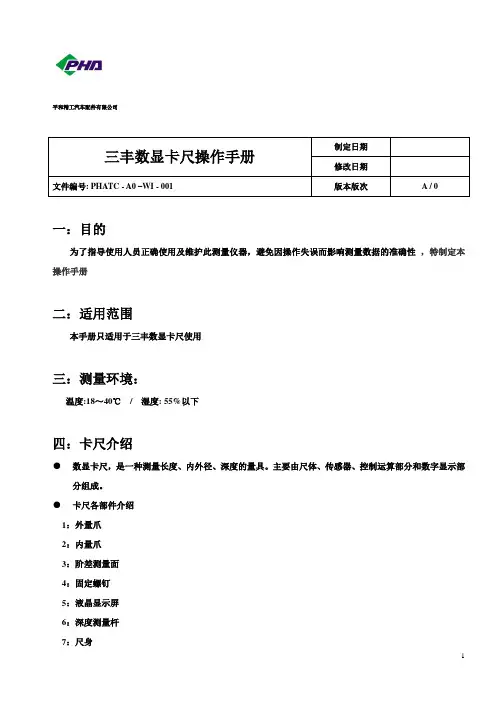
平和精工汽车配件有限公司一:目的为了指导使用人员正确使用及维护此测量仪器,避免因操作失误而影响测量数据的准确性,特制定本操作手册二:适用范围本手册只适用于三丰数显卡尺使用三:测量环境:温度:18~40℃/ 湿度: 55%以下四:卡尺介绍●数显卡尺,是一种测量长度、内外径、深度的量具。
主要由尺体、传感器、控制运算部分和数字显示部分组成。
●卡尺各部件介绍1:外量爪2:内量爪3:阶差测量面4:固定螺钉5:液晶显示屏6:深度测量杆7:尺身8:电池盖9: ZERO/ABS(切换相对测量与绝对测量)10:ON/OFF 按钮11:inch/mm切换按钮12:ORIGN开关13:微调螺旋钮●卡尺常用功能:测外径、内径、高度(深度)、台阶高度等。
●卡尺各部位功能与用途1:外量爪:测量待测件外侧两点间尺寸。
如外径、外长等。
2:内量爪:测量待测件的内侧两点间尺寸。
如内径、内宽等。
3:阶差测量面:测量待测件的台阶高度。
4:锁紧螺钉:需要固定游标滑块在某一位置时,顺时针旋紧螺钉。
5:数字显示屏:测量时,显示所测得的尺寸数据。
6:深度测量杆臂:测量待测件深度。
7:尺身:全尺的主体结构,测量时,通常用右手握住尺身。
9:ZERO/ABS(切换相对测量与绝对测量)★:进行相对测量(INC)时,按以下所述进行:打开卡尺到置零位置,短按ZERO/ABS开关1秒左右,进行显示值的零点设置。
会显示“INC”.此后可以以此为零点开始测量.★: 进行绝对测量(ABS)时,按以下所述进行 ▼ 打开电源时,卡尺总是处于绝对 测量状态,显示绝对数值,▼ 如果未显示“INC ”,可以按原有的状态进行绝对测量.▼ 如果显示屏的左上部显示“INC ”,请按ZERO/ABS 开关2秒以上。
“INC ”消失。
此后可以从绝对圆点进行测量.10:ON/OFF 按钮:进行开关控制 11:inch/mm 切换按钮:英寸和毫米的切换. 12:ORIGN 开关: 进行圆点的设定13: 微调螺旋钮:当需要移动游标滑块较小距离时,可滚动此螺旋钮 。

新杉本贸易教您使用日本三丰游标卡尺的方法:游标卡尺是工业上常用的测量长度的仪器,它由尺身及能在尺身上滑动的游标组成,如图2.3-1所示。
若从背面看,游标是一个整体。
游标与尺身之间有一弹簧片(图中未能画出),利用弹簧片的弹力使游标与尺身靠紧。
游标上部有一紧固螺钉,可将游标固定在尺身上的任意位置。
尺身和游标都有量爪,利用内测量爪可以测量槽的宽度和管的内径,利用外测量爪可以测量零件的厚度和管的外径。
深度尺与游标尺连在一起,可以测槽和筒的深度。
尺身和游标尺上面都有刻度。
以准确到0.1毫米的游标卡尺为例,尺身上的最小分度是1毫米,游标尺上有10个小的等分刻度,总长9毫米,每一分度为0.9毫米,比主尺上的最小分度相差0.1毫米。
量爪并拢时尺身和游标的零刻度线对齐,它们的第一条刻度线相差0.1毫米,第二条刻度线相差0.2毫米,……,第10条刻度线相差1毫米,即游标的第10条刻度线恰好与主尺的9毫米刻度线对齐,如图2.3-2。
当量爪间所量物体的线度为0.1毫米时,游标尺向右应移动0.1毫米。
这时它的第一条刻度线恰好与尺身的1毫米刻度线对齐。
同样当游标的第五条刻度线跟尺身的5毫米刻度线对齐时,说明两量爪之间有0.5毫米的宽度,……,依此类推。
在测量大于1毫米的长度时,整的毫米数要从游标“0”线与尺身相对的刻度线读出。
游标卡尺的使用用软布将量爪擦干净,使其并拢,查看游标和主尺身的零刻度线是否对齐。
如果对齐就可以进行测量:如没有对齐则要记取零误差:游标的零刻度线在尺身零刻度线右侧的叫正零误差,在尺身零刻度线左侧的叫负零误差(这件规定方法与数轴的规定一致,原点以右为正,原点以左为负)。
测量时,右手拿住尺身,大拇指移动游标,左手拿待测外径(或内径)的物体,使待测物位于外测量爪之间,当与量爪紧紧相贴时,即可读数,如图2.3-3所示。
游标卡尺的读数读数时首先以游标零刻度线为准在尺身上读取毫米整数,即以毫米为单位的整数部分。
然后看游标上第几条刻度线与尺身的刻度线对齐,如第6条刻度线与尺身刻度线对齐,则小数部分即为0.6毫米(若没有正好对齐的线,则取最接近对齐的线进行读数)。

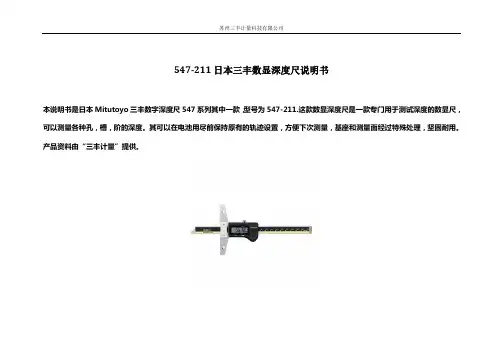
547-211日本三丰数显深度尺说明书本说明书是日本Mitutoyo三丰数字深度尺547系列其中一款,型号为547-211.这款数显深度尺是一款专门用于测试深度的数显尺,可以测量各种孔,槽,阶的深度。
其可以在电池用尽前保持原有的轨迹设置,方便下次测量,基座和测量面经过特殊处理,坚固耐用。
产品资料由“三丰计量”提供。
547-211 Mitutoyo三丰深度尺特点:• ABSOLUTE Digimatic 深度尺可在电池用尽前保持原有的原点轨迹设置。
• 安装延长杆可扩大测量范围。
• 基座底面经过硬化,研磨和抛光处理,具有很高的平面度。
• 背置活塞型指针式千分表可从正上方的垂直表盘进行读数(7231, 7237, 7238)。
• 带有SPC 数据输出(547 系列)。
Mitutoyo三丰深度尺技术参数:数显型技术参数精度: 参见性能参数(数显型号不包括量化偏差)分辨率: 0.001mm, 0.01mm, .00005"/0.001mm 或.0005"/0.01mm基座面平面度: 5μm 或2μm测头: 硬质合金球型测头或针型测头测力: 1.5N显示: LCD电池: SR44 (1 个), 938882电池寿命: 正常使用情况下约为5000 小时带表型技术参数:精度: 参见性能参数(数显型号不包括量化偏差)表盘读数值: 0.01mm 或 .001"基座面平面度: 5μm 或2μm测头: 硬质合金球型测头(测头: 7210, 7222)测力: 1.4N (2.5N: 7213, 7214, 7217, 7218)数显型功能:原点设置、调零、数据保持、数据输出、英制/公制转换(英制/公制型)警告: 低电压、计算错误数显型选件:905338: SPC 电缆(1m)905409: SPC 电缆(2m)Mitutoyo三丰深度尺性能参数:公制型:英制/公制型:。
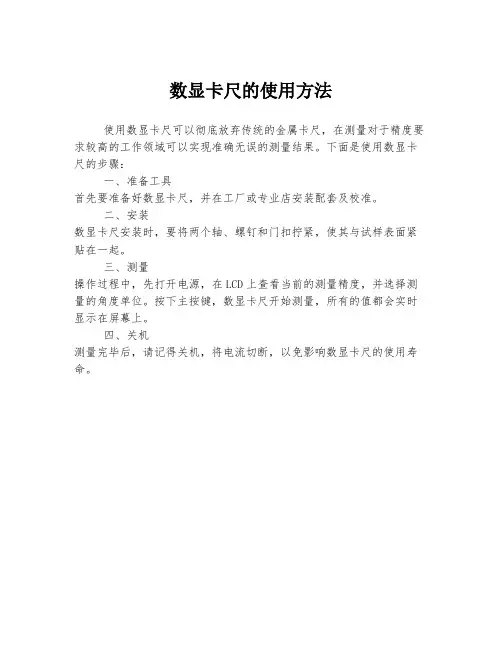
数显卡尺的使用方法
使用数显卡尺可以彻底放弃传统的金属卡尺,在测量对于精度要求较高的工作领域可以实现准确无误的测量结果。
下面是使用数显卡尺的步骤:
一、准备工具
首先要准备好数显卡尺,并在工厂或专业店安装配套及校准。
二、安装
数显卡尺安装时,要将两个轴、螺钉和门扣拧紧,使其与试样表面紧贴在一起。
三、测量
操作过程中,先打开电源,在LCD上查看当前的测量精度,并选择测量的角度单位。
按下主按键,数显卡尺开始测量,所有的值都会实时显示在屏幕上。
四、关机
测量完毕后,请记得关机,将电流切断,以免影响数显卡尺的使用寿命。
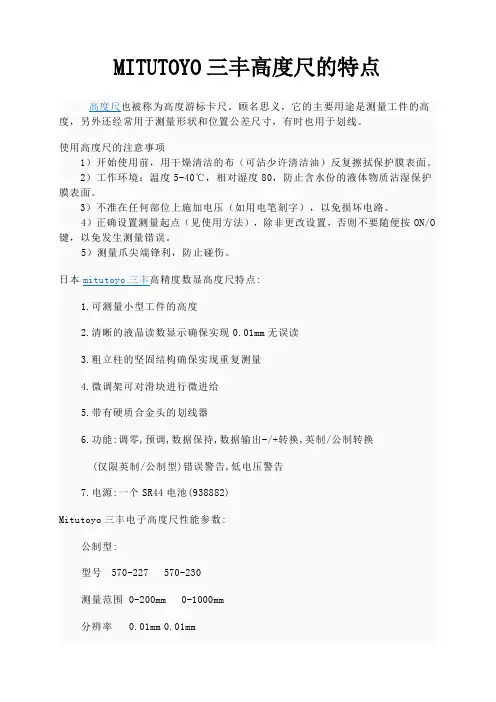
MITUTOYO三丰高度尺的特点高度尺也被称为高度游标卡尺。
顾名思义,它的主要用途是测量工件的高度,另外还经常用于测量形状和位置公差尺寸,有时也用于划线。
使用高度尺的注意事项1)开始使用前,用干燥清洁的布(可沾少许清洁油)反复擦拭保护膜表面。
2)工作环境:温度5-40℃,相对湿度80,防止含水份的液体物质沾湿保护膜表面。
3)不准在任何部位上施加电压(如用电笔刻字),以免损坏电路。
4)正确设置测量起点(见使用方法),除非更改设置,否则不要随便按ON/O 键,以免发生测量错误。
5)测量爪尖端锋利,防止碰伤。
日本mitutoyo三丰高精度数显高度尺特点:1.可测量小型工件的高度2.清晰的液晶读数显示确保实现0.01mm无误读3.粗立柱的坚固结构确保实现重复测量4.微调架可对滑块进行微进给5.带有硬质合金头的划线器6.功能:调零,预调,数据保持,数据输出-/+转换,英制/公制转换(仅限英制/公制型)错误警告,低电压警告7.电源:一个SR44电池(938882)Mitutoyo三丰电子高度尺性能参数:公制型:型号570-227 570-230测量范围 0-200mm 0-1000mm分辨率0.01mm 0.01mm精度±0.03mm ±0.07mm重复精度 0.01mm 0.01mm英制/公制型型号570-244 570-248测量范围 0-8"/0-200mm 0-40"/0-1000mm 分辨率.0005"/0.01mm .0005"/0.01mm 精度±.001" ±.003"重复精度 0.01mm 0.01mm。
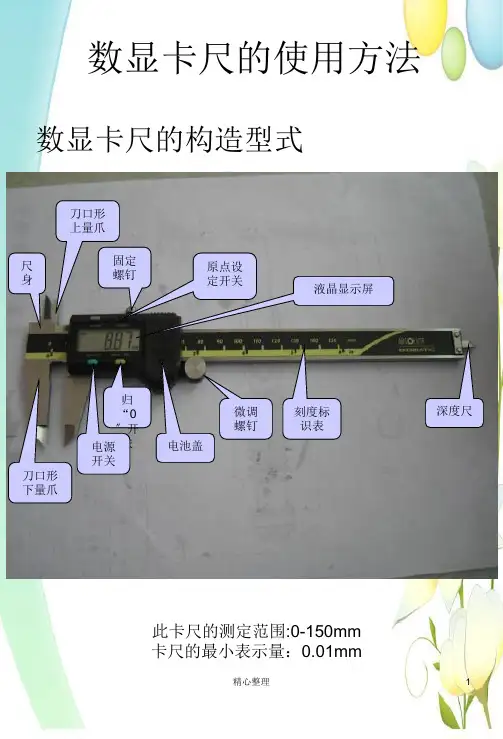
三丰高度规设置说明书【详尽版】三丰高度规设置说明书内容来源网络,由“深圳机械展(11万㎡,1100多家展商,超10万观众)”收集整理!更多cnc加工中心、车铣磨钻床、线切割、数控刀具工具、工业机器人、非标自动化、数字化无人工厂、精密测量、3D打印、激光切割、钣金冲压折弯、精密零件加工等展示,就在深圳机械展.一、含义三丰高度规也叫三丰千分表,三丰高度规是高度规中在国内使用比较广泛的高度规之一,是日本株式会社三丰研发生产的一种简单、易于现场使用、便于携带的一种测量高度、深度的量具。
三丰高度规分类1 .DigimaticDigimatic千分表高度规为数显读数,有效避免了测量过程中出现误读。
它特有绝对原点型线性编码器可在电池耗尽前始终保持所设置的原点轨道。
开机可在大型液晶显示上显示心轴距离原点的实际位置。
2.指针式指针式千分表高度规不同于其他类型的指针式千分表高度规,其整个指针可单转完整地显示整个心轴量程或范围,有效地避免了多转计算错误导致误读的可能,使用单转指针千分表高度规永远不会出现混淆“公差范围”和“视差范围”的情况。
采用独特的防震结构,耐冲击力性强。
有效防止心轴突然缩进导致的冲击。
3.杠杆三丰杠杆千分表高度规可测量普通高度规测量不到的位置,可以满足校准和测量目的。
它的特点是全新结构确保指针平滑运动,框架硬度高,防磁性强,清晰简洁。
二、操作说明书日本三丰高度规的具体操作步骤如下:1.首先,我们先根据待测量的样品尺寸选择适当量程的高度规。
2.选好之后,检查校正日期是否在使用周期内,使用前要确定好高度规有无校准标签。
3.接下来我们打开电源的开关,按一下f2校准按钮,校准的时候要用标准量块,当显示屏出现0.000 时说明仪器已经将测针进行了补偿了。
4. 依图面基准和被测样品特性,把样品装平在大理石平台,开始对待测样品进行量测。
5. 这个时候我们可以通过显示屏上显示的数据来记录下我们所要的数据。
6. 最后一点不要忘记了,使用完高度规以后要将高度规放回原位,并清理干净平台。
深度尺的正确使用方法和读法深度尺是一种用于测量物体深度的工具,它在工程、建筑、制造等领域都有着广泛的应用。
正确的使用方法和读法对于保证测量的准确性至关重要。
下面我们将介绍深度尺的正确使用方法和读法。
首先,要确保深度尺的清洁和平整。
在使用深度尺之前,应该先清洁测量表面,确保没有杂物或污垢影响测量的准确性。
同时,也要确保深度尺的刻度清晰可读,没有损坏或模糊的情况。
接着,将深度尺垂直放置在需要测量的物体表面上。
在进行测量时,要确保深度尺与物体表面垂直接触,避免出现倾斜造成的误差。
同时,要轻轻按压深度尺,确保其与物体表面完全接触。
然后,读取深度尺的刻度数值。
在读取深度尺时,要注意从最接近物体表面的刻度开始读取。
通常情况下,深度尺的刻度是从0开始,然后逐渐增加的。
在读取时,要注意刻度线与刻度线之间的间隔,确保准确地读取出深度尺所指示的数值。
此外,要注意深度尺的刻度单位。
不同的深度尺可能采用不同的刻度单位,例如毫米、厘米、英寸等。
在进行测量时,要确保使用相同的刻度单位进行读取和记录,避免单位转换带来的误差。
最后,进行多次测量并取平均值。
为了确保测量结果的准确性,通常情况下需要进行多次测量,并将测量结果取平均值。
这样可以有效地减小由于个别误差带来的影响,提高测量的准确性和可靠性。
总之,深度尺的正确使用方法和读法对于保证测量的准确性至关重要。
在使用深度尺时,要注意清洁和平整、垂直放置、准确读取刻度数值、注意刻度单位以及进行多次测量取平均值等步骤,以确保测量结果的准确性和可靠性。
希望以上内容能够帮助大家更好地掌握深度尺的正确使用方法和读法。
547-211日本三丰数显深度尺说明书
本说明书是日本Mitutoyo三丰数字深度尺547系列其中一款,型号为547-211.这款数显深度尺是一款专门用于测试深度的数显尺,可以测量各种孔,槽,阶的深度。
其可以在电池用尽前保持原有的轨迹设置,方便下次测量,基座和测量面经过特殊处理,坚固耐用。
产品资料由“三丰计量”提供。
547-211 Mitutoyo三丰深度尺特点:
• ABSOLUTE Digimatic 深度尺可在电池用尽前保持原有的原点轨迹设置。
• 安装延长杆可扩大测量范围。
• 基座底面经过硬化,研磨和抛光处理,具有很高的平面度。
• 背置活塞型指针式千分表可从正上方的垂直表盘进行读数(7231, 7237, 7238)。
• 带有SPC 数据输出(547 系列)。
Mitutoyo三丰深度尺技术参数:
数显型技术参数
精度: 参见性能参数(数显型号不包括量化偏差)
分辨率: 0.001mm, 0.01mm, .00005"/0.001mm 或.0005"/0.01mm
基座面平面度: 5μm 或2μm
测头: 硬质合金球型测头或针型测头
测力: 1.5N
显示: LCD
电池: SR44 (1 个), 938882
电池寿命: 正常使用情况下约为5000 小时
带表型技术参数:
精度: 参见性能参数(数显型号不包括量化偏差)
表盘读数值: 0.01mm 或 .001"
基座面平面度: 5μm 或2μm
测头: 硬质合金球型测头(测头: 7210, 7222)
测力: 1.4N (2.5N: 7213, 7214, 7217, 7218)
数显型功能:
原点设置、调零、数据保持、数据输出、英制/公制转换(英制/公制型)警告: 低电压、计算错误
数显型选件:
905338: SPC 电缆(1m)905409: SPC 电缆(2m)Mitutoyo三丰深度尺性能参数:公制型:
英制/公制型:。